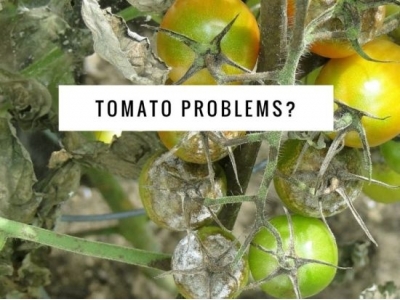Troubleshooting Tomato Problems

There is no better feeling in the world than walking into your own garden and picking a big, red, juicy tomato off of the vine. Slicing into the gorgeous fruit and putting it onto your sandwich can be almost as satisfying as eating it. Homegrown, vine ripened tomatoes are one of the best things about summer!
As great as the feeling of your own fresh tomatoes can be, the feeling of utter dismay can be accompanied with growing them too. Pests munching on the plant can destroy your crop of delicious fruit. Disease can ravage the plant to the point of death. If that happened, it would be a horrible summer without a bountiful harvest of tomatoes.
LOOKING FOR SIGNS OF PEST DAMAGE
First off, before troubleshooting for pest problems, it is important to remove all weeds and grasses from the planting bed. Remove all mulch from the area to expose as much of the soil as possible.
There are numerous things to look for while checking for tomato pests. Leaves with holes on them are common signs of a variety of pests. Most gardeners know what healthy plants look like. If your tomato plant doesn’t appear to be doing well, an investigation is needed.
TOP 3 TOMATO PESTS
Tomato Fruitworm
The fruit worm is a very common bug that can ruin a crop of yummy tomatoes. Fruit worms are approximately 1 1/2 inch in length and are a green-yellow color. They have 6 legs and 10 pro-legs. These pests burrow holes into the tomato and will make it inedible. Applying an insecticide that contains methymyl will clear up the fruit worm problem readily. Also, if you catch them early enough you can hand pick them off the plant for an organic pest control option.
Leaf Miners
Leaf miners are nasty little buggers that create holes in the tomato plant’s leaves. They are less than a tenth of an inch long and can be transparent or vivid yellow. Their heads are pointy. Using a microbial insecticide will get rid of leaf-miners and save your crop.
Whiteflies
Greenhouse whiteflies are persistent little bugs that are similar in body style to moths. They have a yellowish hue to them. They eat the sap from your tomato plants. They cause the plant to stop growing normally as well as yellowing of the leaves, leaf dropping and lack of proper fruit production. The leaves and stem should be treated with insecticidal soap to remove and resist further infestation of whiteflies.

TOP 3 TOMATO DISEASES
There are many signs of disease. Leaf issues and lack of thriving tend to be the most common symptoms. Check out the signs of the top three tomato diseases: Early Blight, Late Blight, and Verticillium Wilt.
Early Blight
Dark, ringed spots on leaves, yellow leaves or dead leaves can be a sign of Early Blight. These leaf problems will cause any growing fruits to be burned up by the sun. The bio-fungal insecticide named Serenade will help stop further fungal growth. It is pertinent that all plants be removed in fall as the fungi will survive through the winter and attack new plants in the spring. All debris should be removed from the garden area to prevent continued growth for the next season.
Late Blight
Late Blight was the nasty disease that caused the Great Irish Potato Famine. It caused many deaths and created the influx of Irish into America. The tomato leaves will have greasy gray spots with an area of white mold around it occasionally. This is highly contagious to other plants but Serenade will deter growth, it will not kill the disease. A thorough cleaning of the garden is warranted as Late blight will exist in the soil until new plants are installed and it will flourish again.
Verticillium Wilt
Verticillium Wilt will cause your tomato plant’s leaves to dry up and turn yellow. The name of the disease makes you think the leaves will wilt but they don’t. This fungus lives in the soil and can survive for several years without a host plant. Verticullium Wilt stops the plant from being able to absorb water which eventually will kill the plant. There are no treatments for it. The garden must be cleaned and left barren until the disease is no longer present.
IDENTIFYING A NUTRIENT DEFICIENCY IN TOMATOES
Nitrogen Deficiency
Nitrogen is essential for your tomato plant’s proper and healthy leaf growth. If your soil is lacking in Nitrogen, the plants will have smaller leaf growth, yellowed leaves, less shoot extension and minimal fruit production. Adding the proper amount of fish emulsion to the garden area will cure the problem. Do not add more than is required. Too much Nitrogen causes the plant to focus too much on growth, and not on stable root systems or fruit production.
Phosphorous Deficiency
Tomato plants that show a reddish or purplish hue to their leaves might have a phosphorous deficiency. The stems can be slender with leaf mottling as well as minimal fruit growth, if any. Finely ground up rock phosphate will do the trick. Too much cannot harm your tomato plant so don’t be frugal with its use. It will not harm the plant.
Có thể bạn quan tâm
 Growing Potatoes From Store Bought Potatoes
Growing Potatoes From Store Bought Potatoes When deep winter snows cover the ground, many of us tend to dream of harvesting succulent fresh vegetables and fruits.
 Sweet William: Growing from Seed
Sweet William: Growing from Seed The Sweet William flower (Dianthus barbatus), hardy in USDA plant hardiness zones 3 through 9, is charming tucked in containers, mixed with other perennials
 Tomato Growing Problems From Improper Watering
Tomato Growing Problems From Improper Watering Probably the single most common mistake made by gardeners growing tomatoes involves watering them. Sometimes it’s too much, other times it’s not enough